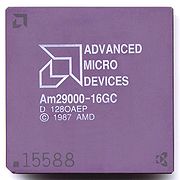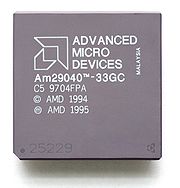
AMD Am29000
Encyclopedia


Microprocessor
A microprocessor incorporates the functions of a computer's central processing unit on a single integrated circuit, or at most a few integrated circuits. It is a multipurpose, programmable device that accepts digital data as input, processes it according to instructions stored in its memory, and...
s and microcontroller
Microcontroller
A microcontroller is a small computer on a single integrated circuit containing a processor core, memory, and programmable input/output peripherals. Program memory in the form of NOR flash or OTP ROM is also often included on chip, as well as a typically small amount of RAM...
s developed and fabricated by Advanced Micro Devices
Advanced Micro Devices
Advanced Micro Devices, Inc. or AMD is an American multinational semiconductor company based in Sunnyvale, California, that develops computer processors and related technologies for commercial and consumer markets...
(AMD). They were, for a time, the most popular RISC chips on the market, widely used in laser printer
Laser printer
A laser printer is a common type of computer printer that rapidly produces high quality text and graphics on plain paper. As with digital photocopiers and multifunction printers , laser printers employ a xerographic printing process, but differ from analog photocopiers in that the image is produced...
s from a variety of manufacturers. In late 1995 AMD dropped development of the 29k because the design team was transferred to support the PC side of the business. What remained of AMD's embedded business was realigned towards the embedded 186 family of 80186
Intel 80186
The 80188 is a version with an 8-bit external data bus, instead of 16-bit. This makes it less expensive to connect to peripherals. The 80188 is otherwise very similar to the 80186. It has a throughput of 1 million instructions per second....
derivatives. The majority of AMD's resources were then concentrated on their high-performance, desktop x86 clones, using many of the ideas and individual parts of the latest 29k to produce the AMD K5
AMD K5
The K5 was AMD's first x86 processor to be developed entirely in-house. Introduced in March 1996, its primary competition was Intel's Pentium microprocessor. The K5 was an ambitious design, closer to a Pentium Pro than a Pentium regarding technical solutions and internal architecture...
.
The 29000 evolved from the same Berkeley RISC
Berkeley RISC
Berkeley RISC was one of two seminal research projects into RISC-based microprocessor design taking place under ARPA's VLSI project. RISC was led by David Patterson at the University of California, Berkeley between 1980 and 1984, while the other was taking place only a short drive away at Stanford...
design that also led to the Sun
Sun Microsystems
Sun Microsystems, Inc. was a company that sold :computers, computer components, :computer software, and :information technology services. Sun was founded on February 24, 1982...
SPARC
SPARC
SPARC is a RISC instruction set architecture developed by Sun Microsystems and introduced in mid-1987....
and Intel
Intel Corporation
Intel Corporation is an American multinational semiconductor chip maker corporation headquartered in Santa Clara, California, United States and the world's largest semiconductor chip maker, based on revenue. It is the inventor of the x86 series of microprocessors, the processors found in most...
i960
Intel i960
Intel's i960 was a RISC-based microprocessor design that became popular during the early 1990s as an embedded microcontroller, becoming a best-selling CPU in that field, along with the competing AMD 29000...
. One "trick" used in all of the Berkeley
University of California, Berkeley
The University of California, Berkeley , is a teaching and research university established in 1868 and located in Berkeley, California, USA...
-derived designs is the concept of register window
Register window
In computer engineering, the use of register windows is a technique to improve the performance of a particularly common operation, the procedure call...
s, a technique used to speed up procedure calls significantly. The basic idea is to use a large set of registers
Processor register
In computer architecture, a processor register is a small amount of storage available as part of a CPU or other digital processor. Such registers are addressed by mechanisms other than main memory and can be accessed more quickly...
as a stack, loading local data into a set of registers during a call, and marking them "dead" when the procedure returns. Values being returned from the routines would be placed in the "global page", the top eight registers in the SPARC (for instance). It is interesting to note that the competing early RISC design from Stanford University
Stanford University
The Leland Stanford Junior University, commonly referred to as Stanford University or Stanford, is a private research university on an campus located near Palo Alto, California. It is situated in the northwestern Santa Clara Valley on the San Francisco Peninsula, approximately northwest of San...
, the Stanford MIPS, also looked at this concept but decided that improved compilers could make more efficient use of general purpose registers than a hard-wired window, something that has proven true over the years.
In the original Berkeley design, SPARC, and i960, the windows were fixed in size. A routine using only one local variable would still use up eight registers on the SPARC, wasting this expensive resource. It was here that the 29000 differed from these earlier designs, in that it used a variable window size to improve usage. In this example only two registers would be used, one for the local variable, another for the return address
Return address
In postal mail, a return address is an explicit inclusion of the address of the person sending the message. It provides the recipient with a means to determine how to respond to the sender of the message if needed....
. It also added more registers, including the same 128 registers for the procedure stack, but adding another 64 for global access. In comparison the SPARC had 128 registers in total, and the global set was a standard window of eight. These changes, combined with a "halfway smart" compiler, resulted in the best of both worlds in performance—high performance for procedure calls, while still having lots of global registers for general purpose work. The 29000 also "extended" the register window stack with an in-memory (and in theory, in-cache) stack. When the window filled the calls would be pushed off the end of the register stack into memory, restored as required when the routine returned. Generally the 29000's register usage was considerably more advanced than competing designs based on the Berkeley concepts.

Superscalar
A superscalar CPU architecture implements a form of parallelism called instruction level parallelism within a single processor. It therefore allows faster CPU throughput than would otherwise be possible at a given clock rate...
, so it could not "do both sides" as is common in some designs). The buffer mitigated this by storing four instructions from the "other side" of the branch, which could be run instantly while the buffer was re-filled with new instructions from memory.
The first 29000 was released in 1988, including a built-in MMU
Memory management unit
A memory management unit , sometimes called paged memory management unit , is a computer hardware component responsible for handling accesses to memory requested by the CPU...
but floating point
Floating point
In computing, floating point describes a method of representing real numbers in a way that can support a wide range of values. Numbers are, in general, represented approximately to a fixed number of significant digits and scaled using an exponent. The base for the scaling is normally 2, 10 or 16...
support was offloaded to the 29027 FPU
Floating point unit
A floating-point unit is a part of a computer system specially designed to carry out operations on floating point numbers. Typical operations are addition, subtraction, multiplication, division, and square root...
. The 29005 was a cut-down version. The line was upgraded with the 29030 and 29035, which included an 8 KB or 4 KB of instruction cache, respectively. Another update integrated the FPU on-die and added a 4 KB data cache to produce the 29040.
The final general-purpose version was the 29050. The 29050 also has much better floating point performance than previous 29k microprocessors.
Several portions of the 29050 design were used as the basis for the K5
AMD K5
The K5 was AMD's first x86 processor to be developed entirely in-house. Introduced in March 1996, its primary competition was Intel's Pentium microprocessor. The K5 was an ambitious design, closer to a Pentium Pro than a Pentium regarding technical solutions and internal architecture...
series of x86-compatible processors. The FPU was used unmodified, while the rest of the core design was used along with complex microcode
Microcode
Microcode is a layer of hardware-level instructions and/or data structures involved in the implementation of higher level machine code instructions in many computers and other processors; it resides in special high-speed memory and translates machine instructions into sequences of detailed...
to translate x86 instructions to 29k-like code on the fly.
External links
- AMD 29k (Streamlined Instruction Processor) ID Guide pdf book about 29k family
- chipdb.org Images of different Am29000 processors

